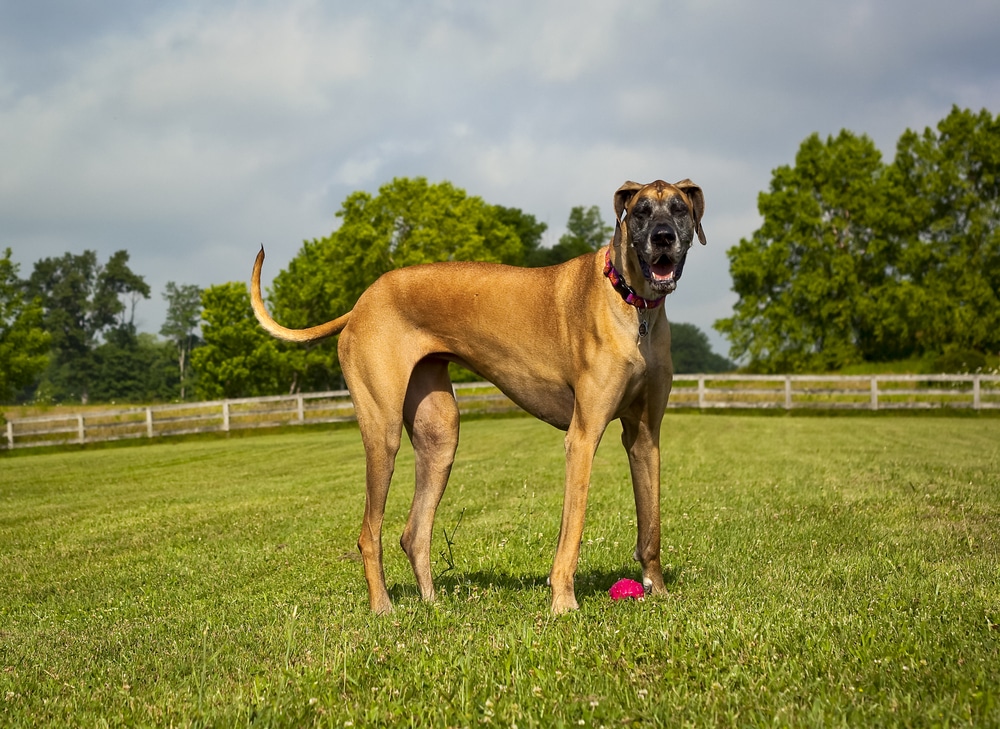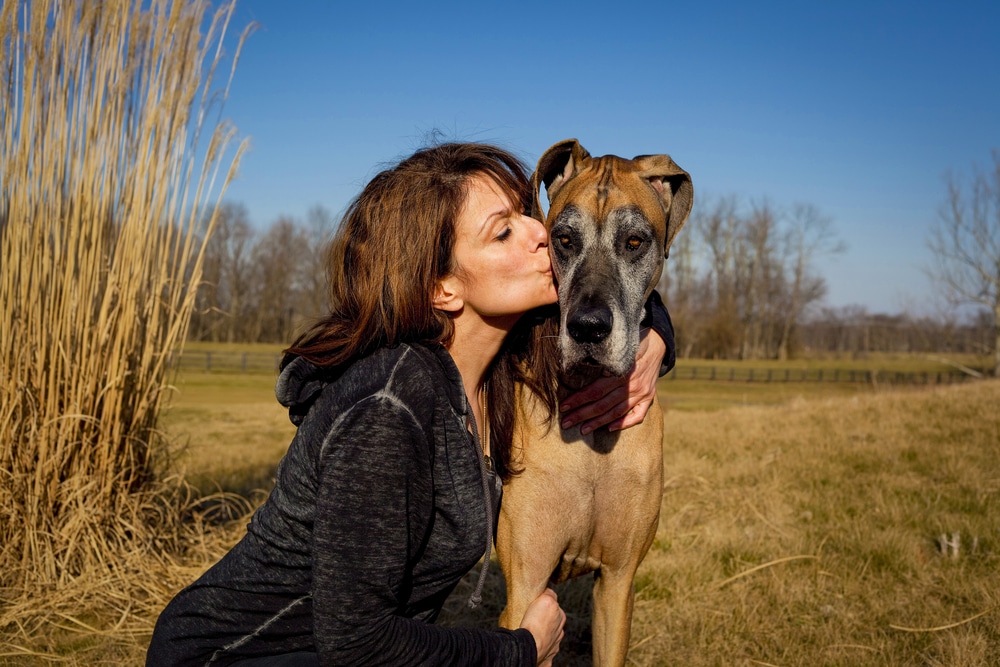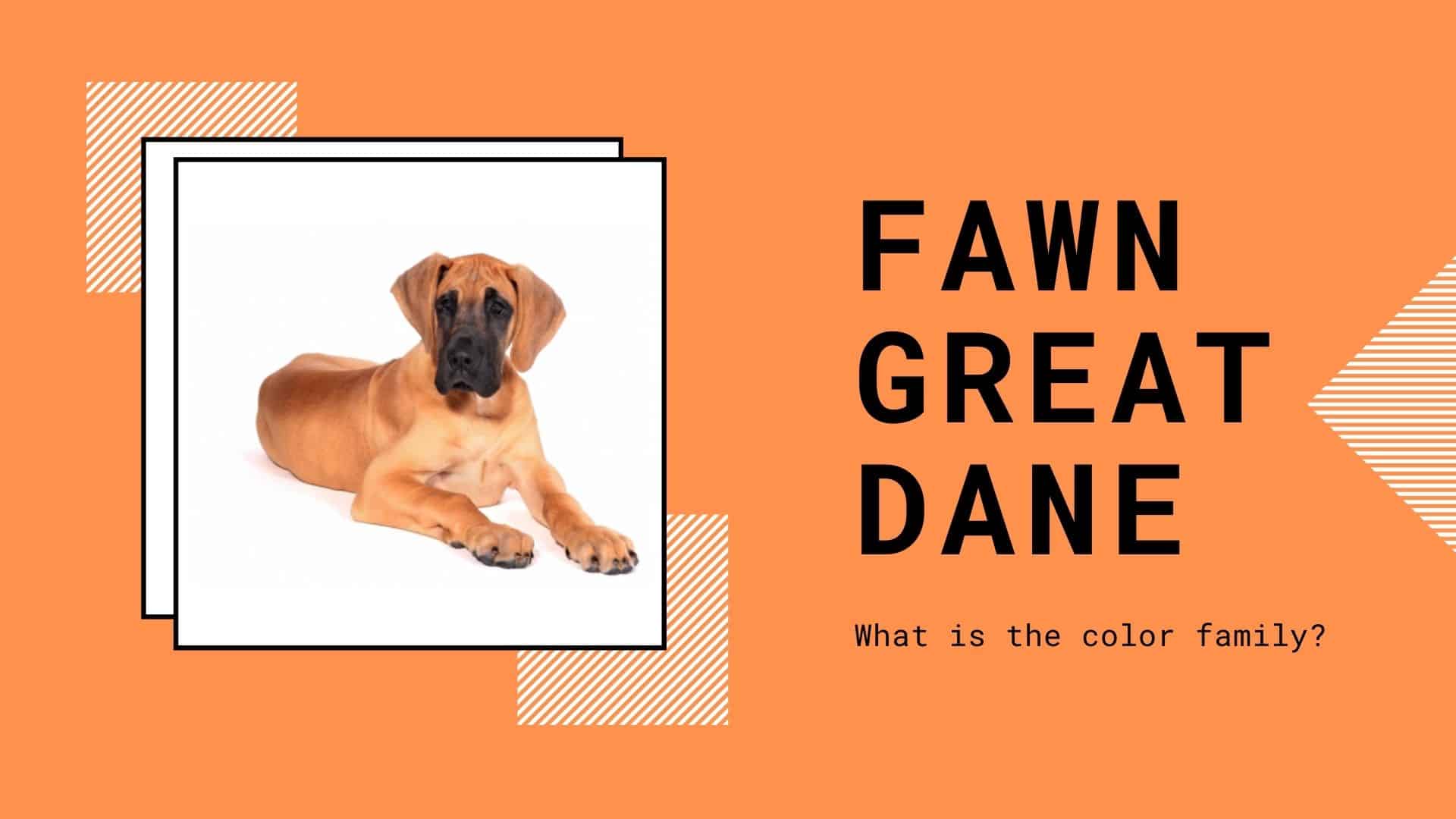“This post contains affiliate links, and I will be compensated if you make a purchase after clicking on my links.”
Last Updated on June 21, 2023
A Fawn Great Dane is the most common and popular Great Dane color. When people think of the Great Dane breed, they mostly think about a Fawn-colored Dane. And this is thanks to popular mainstream media characters like Scooby Doo and Marmaduke.
In this article, you’ll learn everything you need to know about this popular and alluring Great Dane coat color!
Appearance

The Fawn Great Dane is the most popular Great Dane coat color, and it is for good reason. Among all the Great Dane coat colors, they are the easiest to identify thanks to their stunning golden yellow coat that covers their whole body.
The Fawn color is a shade of light yellowish brown that ranges from different tones, namely:
- Pale tan
- Golden yellow
- Light red
Fawn Color Prevalence
The Fawn coat color is a beautiful shade of brown that is also common in other dog breeds. And dogs with this coat color have this natural, clean and earthy appearance. Other famous dog breeds with the same color are Pugs, Boxers, Bloodhounds, Chow Chows, Cocker Spaniels and Chihuahuas.
AKC Standards for Fawn Great Danes
Like other Great Dane coat colors, the American Kennel Club (AKC) has strict standards when it comes to the Fawn Great Dane’s colors, markings and patterns.
The following are a Fawn Dane’s coat color standards:
- The color shall be yellow gold.
- Black should appear on the eye rims and eyebrows with a black mask and may appear on the ears and tail tip.
- Deep yellow gold must always be given the preference.
- White markings on the chest or toes, black-fronted; dirty colored Fawns; are not desirable.
Let’s discuss these standards below, shall we?
The first point, which is pretty self-explanatory, explains that a Fawn Great Dane’s coat color shall be a yellow gold color.
The second point discusses that a Fawn Great Dane’s eye rims, eyebrows and muzzle should be black. Furthermore, having black hair on their ears and tail tip is also acceptable.
The third point puts emphasis on the shade of Fawn that is most desirable and preferable, which is a deep yellow gold.
And the final point explains that white markings on a Fawn’s chest or toes are not acceptable. Having a black chest and being a dirty-colored Fawn are also considered undesirable as per AKC standards. A dirty-colored Fawn is called as such because it can have different coat colors (like black or white) mixed into its solid Fawn coat, making the Great Dane’s clean golden yellow appearance look “dirty”.
Mismarked Fawn Great Danes
Fawn Great Danes also have mismarks. And these mismarks do not meet all of AKC’s standards for Fawns. Because of this, they are not allowed to compete in dog shows.
Although they do not carry the correct colors according to AKC’s standard, mismarks still make great family pets. Below, you’ll find a list of mismark Fawn Great Danes:
1. Blue Fawn Great Dane
The Blue Fawn Great Danes are produced from breeding two Blue Great Danes. This Great Dane has the typical fawn-colored coat on its body. Its only difference with the standard Fawn is that instead of a black mask, it has a blue mask.
A Blue Fawn Great Dane’s other distinct features include a blue or grey nose and amber-colored eyes.
2. Fawn Harlequin Great Dane
A Fawn Harlequin Great Dane or Fawnequin is not an acceptable Great Dane color. This Great Dane has the unique color combination of fawn and white. Its base color is still white, like the standard Harlequin, but its patches are fawn instead of black.
Fawnequins are produced when both parents carry the Fawn gene.
3. Fawn Merle Great Dane
The coat patterns on a Fawn Merle Great Dane occurs similarly with that of a Fawnequin. This means that the base color is still the same as a standard Merle, but the color of the patches are fawn instead of black.
4. Fawn Mantle Great Dane
A Fawn Mantle Great Dane’s pattern is similar to a Mantle Great Dane. This mismark carries the blanket pattern of a Mantle but instead of black, the color of the blanket is fawn. It has a white muzzle and white stripe in between its eyes but has black eye rims and ears.
5. Fawn Brindle Great Dane
A Fawn Brindle Great Dane is kind of difficult to identify since a Brindle has a fawn base coat color. At first glance, it looks like a standard Brindle, but the black stripes on this mismark are less noticeable and the fawn base color is more intense.
Breeding

While it’s true that Fawn is the most common Great Dane coat color, Fawn Danes are actually kind of challenging to breed. This is because both of their parents must carry the recessive Fawn gene. And to produce Fawn Great Dane puppies, breeders cross breed between Fawns, Brindles and Harlequins.
When Fawn puppies are born, they have blue eyes, black tails and ears. But as they grow older, their eye color change to a shade of brown.
Grooming
Given the dog’s short, single coat, grooming a Fawn Great Dane is easy. The most important thing to do is brush their hair regularly and bathe them once every two or three weeks. This keeps shedding at a minimum and keeps their coat healthy and shiny.
Moreover, you have to keep their ears clean. Since they have naturally big, floppy ears, they are predisposed to infections. So cleaning their ears should be a part of their grooming routine. However, if you clean their ears and they still get infections, ear cropping might be an option for your Dane.
And of course, you need to trim their nails. Doing this as part of their grooming routine every fifteen days is ideal. However, you can also trim their nails as often as needed. The rule of thumb is that their nails should not touch the ground when they’re standing.
Furthermore, remember to use a proper nail clipper which is safe for large dog breeds like the Great Dane.
Food
The food requirements for Fawn Great Danes are similar to any other Great Dane. You should ensure that puppies and adults are given the correct type of food they need. Adult dog food can have different ingredients that cannot support the growth of a Great Dane puppy.
Their diet, especially while they’re still puppies, should be high-protein and low-fat. They should not eat food that has more than 24% of protein and 14% of fat. Although, if they show signs of any allergies related to their food, you can try slowly transitioning them from dry dog food to a raw diet.
Furthermore, the amount of calories they eat should be according to their age. For example, an adult Fawn Great Dane weighing 120 pounds on average needs about 2500 calories a day.
Elevated dog feeders
Fawn Great Danes are big dogs, hence the need for raised dog feeders. Of course, like all other things, elevated dog feeders should only be used with your Dane’s well-being and comfort in mind.
If your Dane has joint problems, then it’s best to use one. If they’re old and you see that they’re in pain while eating, then elevated dog feeders are the way to go. However, you have to be careful. Some say that using elevated feeders can increase the chances of bloat in Danes. So, keeping an eye on them while they eat with these type of feeders is a must.
Temperament

Great Dane dogs are known for their friendly demeanor. And Fawn Great Danes are no different. They are very loyal, loving, social and obedient dogs. And they make perfect family companions.
These dogs are also calm and intelligent. With these characteristics and their intimidating size, they make the perfect guard dog. Moreover, since they’re very social dogs, they get along well with other animals, including small dogs and even cats.
But of course, all these characteristics differ from dog to dog. And you will still need to socialize and train your Dane accordingly.
Training
A Fawn Great Dane puppy will grow into an enormous dog. And in its first two years, it will grow fast. And with a dog this big, making sure they’re always on their best behavior is necessary.
That means, you’ll have to train them. And it’ll be a lot better to start the training while they’re still young. Great Danes, in general, can be easy to train because they’re considered “people pleasers”.
You can kick off training as soon as you bring the puppy home. This can be as early as 6 to 8 weeks old. Start from basic commands then gradually do behavioral training. Moreover, if you make positive reinforcement a part of their training, the dog can learn quite fast.
Food For Thought
A Fawn Great Dane has a very alluring coat color. And it makes so much sense why they’re the most popular Great Dane coat color.
Even though fawn is a common color among other breeds, there’s just something so special about a Fawn Dane. The dazzling golden yellow coat with the black muzzle looks very clean and eye-catching. And they have an amazing temperament to boot!
If you’ve decided to get a Fawn Great Dane, make sure to get one from a responsible and reputable breeder.
